Astronomers use various types of telescopes to observe the Universe in multiwavelength.
Please look at how the same celestial object can appear completely different depending
on the wavelengths observed.
 JAPANESE VERSION
JAPANESE VERSION
Starlight fills the night sky. However,this is just one facet of the Universe. The Universe shines,not only with visible light which humans can see,but also with various other wavelengths.
The National Astronomical Observatory of Japan (NAOJ) receives many questions like “What does it mean to observe in multiwavelength?”, “Why does NAOJ operate various telescopes?” We created this website to help everyone understand the scientific meaning of multiwavelength observations of the Universe.
A picture of the Universe taken using visible light (the light which humans can see) is just one aspect. By collecting various wavelengths of electromagnetic waves from the Universe, we can unravel the mysteries of the birth and development of the Universe, stars, and the formulation of planetary systems.
Moreover, we encourage you to enjoy not only the explanation of multiwavelength observation, but also the beautiful pictures taken by telescopes throughout the world.
Please enjoy a multifaceted Universe beyond imagination.
![]()
- Production writer:National Astronomical Observatory of Japan
- “Multiwavelength Universe” production team
Shogo Nagayama, Tomoko Ono, Seiichiro Naito,
Chisato Ikuta (ISAS/JAXA) - Editor
- Junichi Watanabe
- Translation
- Hiroko Komiyama, Ramsey Lundock
- Production planning
- KESHIKI Inc.
- Composition/direction
- Takayuki Nyudo
- Design
- Satoru Hase
- Programing
- Hiroyuki Nakamura
- Technical support
- Yukiko Murai, Yuichiro Nishi
“Decipher the Universe by multiwavelength” this 10 min. movie summarizes the kinds of messages hidden in electromagnetic waves of various wavelengths from the distant Universe.
By using the observational results of NAOJ telescopes, such as the Subaru Telescope and ALMA, as examples it explains what can be seen and what can be defined by visible light, infrared, and radio wave observations.
Please watch it in conjunction with this web site. There is an English version.
- PC
- Internet Explorer 9.0 or later
Safari 6 or later
Chrome latest version
Firefox latest version
- Tablet
- iPad (* only iPad is supported)
- Smartphone
- Not supported
- Display
- A minimum size of 1024*768 pixels for comfortable viewing

Now, astronomers observe the Universe with electromagnetic waves across a wide range of wavelengths.
We know that the real nature of the Universe can be seen by expanding the range of “perception” to include wavelengths invisible to the naked eye.
These two colliding galaxies, located 62 million light-years from Earth, are known as the Antennae Galaxy. You can use the Antennae Galaxy observed at different wavelengths as a guide as you navigate the multiwavelength Universe. Image credit: Rolf Olsen

Gamma-rays are electromagnetic waves produced by extremely high energy phenomena.
They are observed in celestial phenomena such as neutron stars, black holes, supernova remnants, and active galactic nuclei. However, the Antennae Galaxy has not been photographed in gamma-rays.
What kind of images of the Universe are gamma-rays able to take?

Gamma-ray observations are conducted in space because Earth’s atmosphere absorbs gamma-rays. We use detectors mounted on satellites to investigate what directions gamma-rays come from.
The image to the right is the map of the whole sky showing the incident directions of gamma-rays and their strengths based on the observation data of the Fermi Gamma-ray Space Telescope.
The light stretching horizontally aligns with the Milky Way Galaxy, and shows the points where gamma-rays originate in the Milky Way. The bright spots spread across the whole sky show the points where gamma-rays come from outside of the Milky Way Galaxy.Image credit: NASA/DOE/Fermi LAT Collaboration
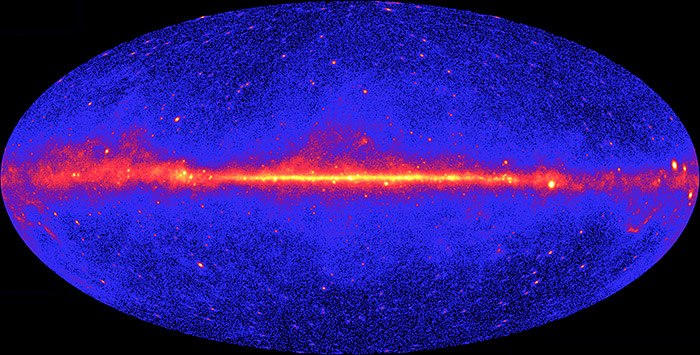 Fermi Gamma-ray Space Telescope
Fermi Gamma-ray Space TelescopeThis whole sky map at gamma-ray wavelengths is made
from two years of observational data.


It is thought that these gamma-rays are emitted from high energy regions like supernova explosions, supernova remnants following the explosions, neutron stars, and black holes.
Currently, the phenomena known as gamma-ray bursts are the focus of intense study. These mysterious phenomena emit an explosive burst of gamma-rays within a short time, only 0.01 seconds to a few minutes. While these phenomena are partially understood, their overall nature remains a mystery. When a gamma-ray burst signal is detected by the satellite, astronomers announce it to the world immediately so that the follow-up observation network, composed of telescopes operating at various wavelengths, can conduct observations in hopes of solving the mystery.Image credit: NASA/Swift/Stefan Immler

Swift Astronomical SatelliteAfter detecting a gamma-ray burst, it sends the information to the world. At the same time it automatically starts observations in X-rays, ultraviolet rays, and visible light using its mounted telescopes. This image is a gamma-ray burst taken in X-rays two minutes after it was detected. Image credit: NASA E/PO, Sonoma State University, Aurore Simonnet


Neutron star or black hole. These are born after a supernova explosion.
High temperature gas bubbles ejected by thousands of supernova explosions are strung together like a huge foam.
There are white points in the bright bluish-white haze. It is so different from how it appears in visible light that it seems like looking at a difference galaxy. This false color image shows the distribution of X-ray strength which is invisible to the naked eye.
What does the Antenna Galaxy seen in X-rays show us?Image credit: NASA/CXC/SAO/J.DePasquale
An X-ray image can capture extremely high energy phenomenon that cannot be seen in visible light. The scattered white lights are thought to be neutron stars and/or black holes which were born at the time of supernova explosions. Neutron stars, with a surface temperature over 100 million °C, shine brightly in X-rays similar to how normal stars shine in visible light. Black holes do not shine themselves, but the gas gathered around them reaches high temperatures and emits strong X-rays.
The broad bluish-white areas are thought to be regions where X-rays are emitted because the gas has been heated to several million °C by the shockwaves from supernova explosions in the galaxy.
X-rays are electromagnetic waves emitted from extremely high temperature regions, several million to several hundred million °C. The observational targets are phenomena caused by explosive energy and strong gravity.
Because X-rays from the Universe are absorbed by Earth’s atmosphere, observations are conducted by space satellites.
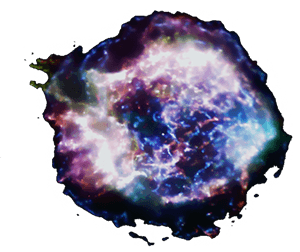
Supernova remnantImage credit : NASA/CXC/SAO

Black hole (conceptual image)Image credit : NAOJ
Neutron star
(conceptual image)
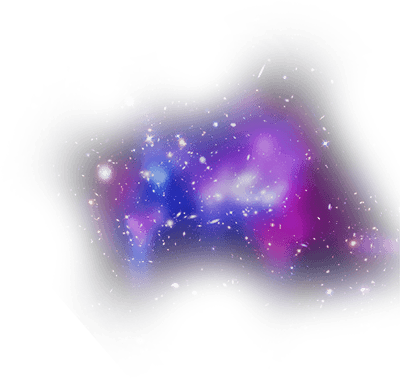
Plasma around
a galaxy clusterImage credit :
NASA/CXC/STScI/IfA/C. Ma et al.


Star forming regions, where high-mass stars are born, can be seen along the arm of the galaxy.
The ultraviolet rays emitted by stars ionize the surrounding gas.
These are observed as nebulae in visible light wavelengths.
Several brightly shining point-like areas are seen within the extended faint glow. The brightly shining regions show areas of strong ultraviolet rays. The overall shape is similar to the shape seen in visible light. What does the Antenna Galaxy seen in ultraviolet show us? Image credit: NASA/GSFC/Swift
Newly formed, high-mass, high-temperature stars shine the brightest in short-wavelength ultraviolet rays rather than in visible light. This image captures the glow emitted by these many stars. It is thought that many heavy stars are forming, especially in the brightest areas.
The shockwave created by galaxies colliding strongly compresses the gas which becomes the raw material for stars, triggering star formation. The ultraviolet rays emitted by the Antenna Galaxy indicate that high-mass stars are born continuously in this galaxy.
The main objects observed in ultraviolet rays are high temperature stars. Observations of the Sun’s corona, which reaches tens-of-thousands °C to several million °C, are done with ultraviolet rays and X-rays.
Observations are done by space telescopes because the ultraviolet rays from the Universe are absorbed by the Earth’s atmosphere.

High mass star
(conceptual image)

Sun’s coronaImage credit : ESA/NASA/SOHO
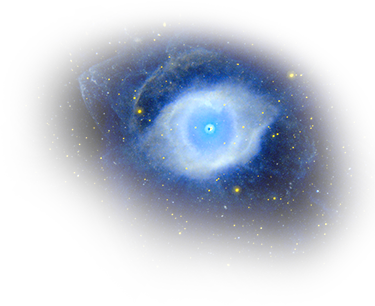
White dwarf at the center
of a planetary nebulaImage credit : NASA/JPL-Caltech/SSC

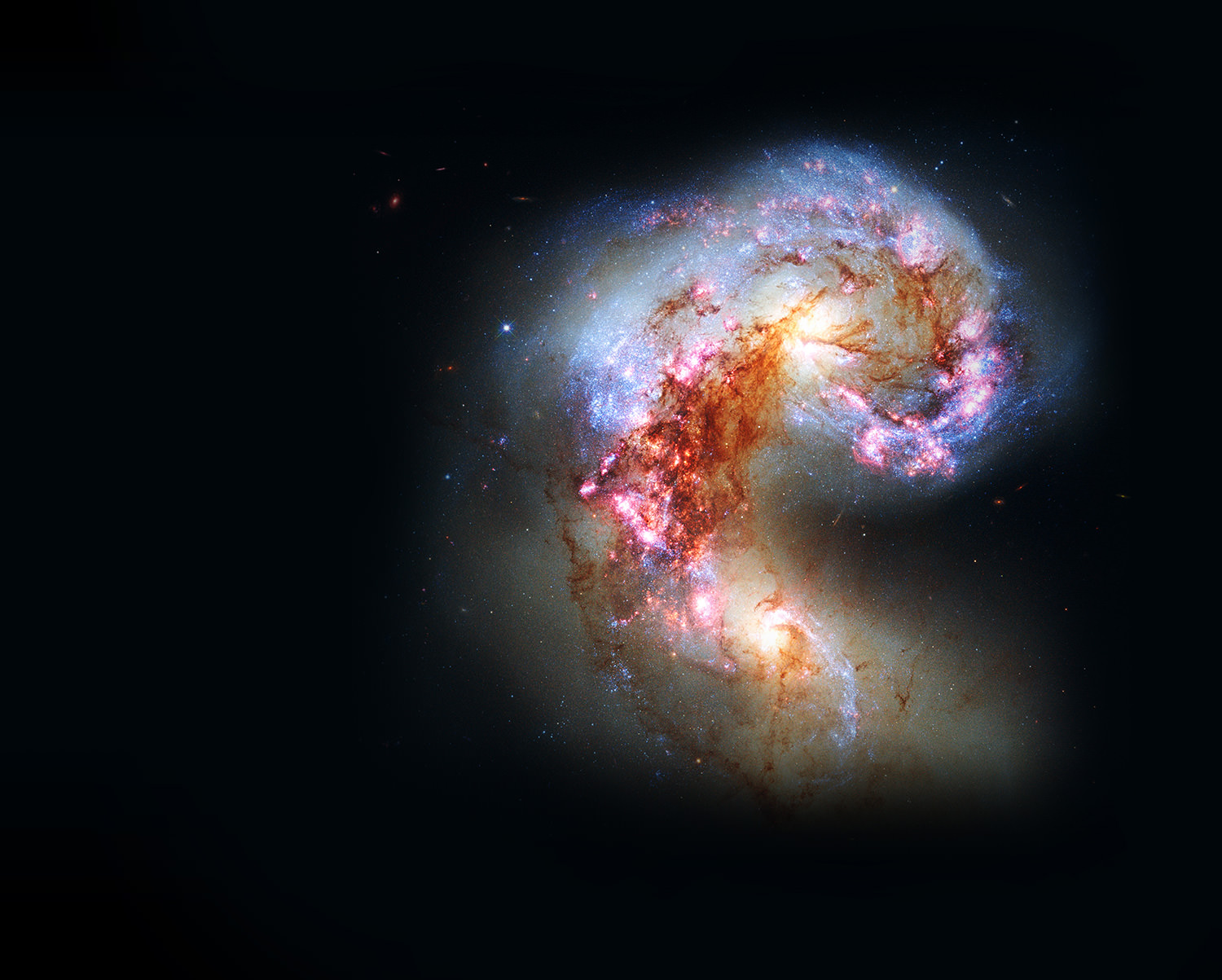

Center of Galaxy
NGC 4038
Region where dusts blocks background starlight

Center of Galaxy NGC 4039. It is thought that before the collision, NGC 4039 was the larger galaxy.
This is the Antenna Galaxy observed in visible light, which can be seen with the naked eye. Compared to images of the Antenna Galaxy captured in other wavelengths, it can precisely capture small lights. In the beautiful light, there are also dark regions in some areas.
What does the Antenna Galaxy seen in visible light show us?Image credit: ESA/Hubble & NASA
The light shown here is the light from innumerable stars. The distribution of the stars comprising the two colliding galaxies is depicted in detail. More than 1000 groups of stars created recently by the energy of the collision have been found.
The dark areas in the galaxy are not regions lacking stars. Thick dust floating in space blocks the light from stars behind it. It is thought that the two colliding galaxies will become a single galaxy.
Most stars shine the strongest in visible light wavelengths. For researching the structure of the collections of gas and stars known as galaxies and the distribution of galaxies in the Universe, observations in visible light are the best.
Visible light not absorbed by Earth’s atmosphere can be observed by optical telescopes on the ground. Space telescope observations, which are not affected by motion in the atmosphere, are also performed.

Galaxyimage credit:NAOJ

Star (conceptual image)

Stars behind dense dust cannot be seen

Nebulaimage credit:NAOJ



We call the distribution of electromagnetic waves at various wavelengths a spectrum. The rainbow made when sunlight passes through a prism is the spectrum of visible light. It is classified as a continuum spectrum because it has a broad wavelength range.
However, looking closely at the solar spectrum, we can find several dark lines cutting into the spectrum which appeared continuous. These are called absorption lines. These appear because the atoms and molecules comprising the Sun’s atmosphere absorb part of the light emitted as a continuum spectrum from the surface of the Sun. Based on their species and state, the atoms and molecules absorb electromagnetic radiation at characteristic wavelengths. Together these absorption lines corresponding to the various characteristic wavelengths are called a line spectrum.
The wavelengths of the absorption lines found through spectral analysis can reveal what kinds of materials a star is made from, even when the star is so distant that even seen through a telescope it appears as nothing more than a point of light. Moreover, by measuring the Doppler Effect exhibited by the wavelengths of the absorption lines, it is even possible to know the velocity and motion of the star. Various messages from stars are contained in the spectrum.image credit:Hida Observatory, Kyoto University / PaoDST WG, PAONET
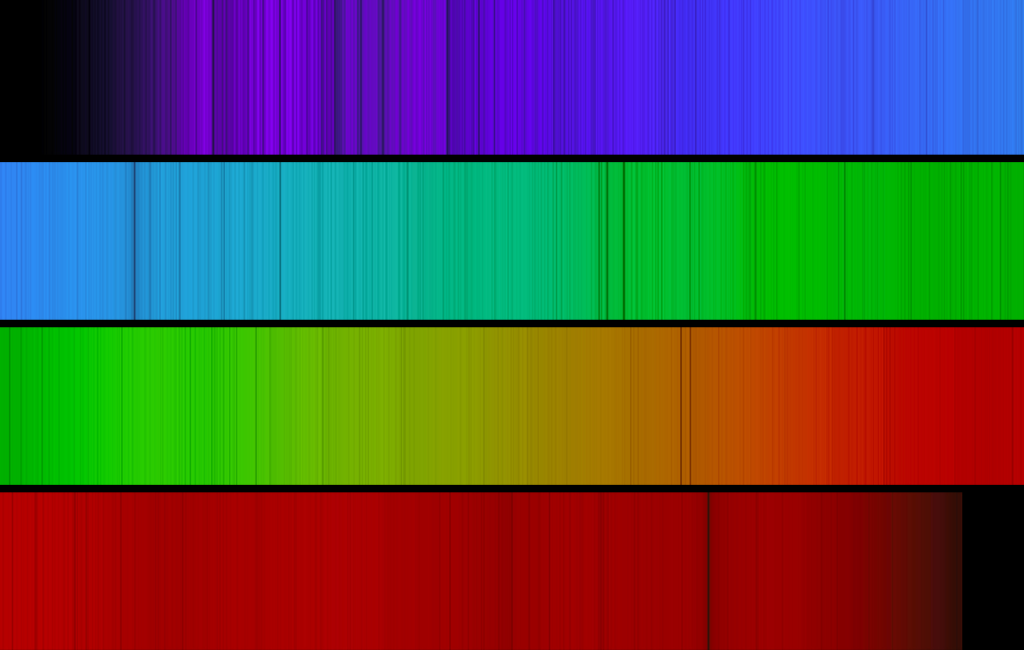

Scattered regions of active star formation.
With infrared, we can see the regions hidden by dust.

The center of the galaxy shrouded in dust shines.
This is the Antenna Galaxy taken in the near infrared, which is the shortest wavelengths of infrared light. The overall image is similar to the shape seen in visible light observations, but a big distinction is that the central parts these two galaxies shine brightly. In addition, localized bright spots are scattered throughout.
What does the Antenna Galaxy seen in infrared show us?
Image credit: Bernhard Brandl and the WIRC team (Cornell), Palomar Observatory
The main celestial objects observable in infrared are stars, the same as for ultraviolet rays and visible light. The Antenna Galaxy shown here consists of light from countless stars.
Because the stars seen in near infrared light have lower temperatures than stars which emit strongly in visible light, the number of young stars starting to shine in star forming regions increases. The scattered bright regions are thought to be places where stars are actively forming. Also, infrared has the capability to pass through dust. So it can capture starlight from the center of the galaxy that cannot be seen in visible light.
Infrared light is more suitable for observing low temperature celestial objects than visible light is. We can see low temperature stars in near infrared, and dust warmed by stars in mid infrared.
Near infrared, close to visible light, can be observed by ground based telescopes if the telescope is at high elevation with thin atmosphere. Long wavelength infrared is observed by space telescopes.

Young star in star forming region
(conceptual image)

Starlight behind dust
(conceptual image)

NebulaImage credit : NASA/JPL-Caltech

Dust (conceptual image)

Protoplanetaly diskImage credit : NAOJ


SXDF-NB1006-2, discovered by the Subaru Telescope, is one of the most distant galaxies ever observed. The faint light of the spectral line emitted by hydrogen atoms arriving at the Earth from 129.1 billion light-years away was observed in the near infrared.
However, it is known that this spectral line originated as ultraviolet rays with a wavelength of 121.6 nanometers. Why was a spectral line emitted with a wavelength in the ultraviolet region observed as near infrared?
The reason is that the expansion of the Universe has been continuing since the Big Bang. Because the space the electromagnetic wave is traveling through is itself expanding, the wavelength of the electromagnetic wave is also stretched. This is called red shift. It is found that the more distant the origin of the electromagnetic wave, the larger the effect of red shift is.
Actually, the distance to SXDF-NB1006-2 was calculated by using this red shift. By calculating how much the spectral line has stretched from the original wavelength, the distance the electromagnetic wave has traveled, in other words the distance to the object, can be estimated. image credit:NAOJ
The light of SXDF-NB1006-2 which has had its wavelength stretched from ultraviolet to near infrared by red shift.Image credit: NAOJ

Gas, the material for star formation, can be seen in regions which are dark in visible light.

Spiral structure is visible.
The image of the Antenna Galaxy seen in radio waves is totally different from the one taken in visible light. In this image the false color red, pink, and yellow are assigned to different wavelengths of radio waves. Short wavelength radio waves, especially the wavelengths called submillimeter waves, are strong at the centers of the galaxies and the part connecting the two galaxies.
What does the Antenna Galaxy seen in radio waves show us?Image credit: ALMA (ESO/NAOJ/NRAO)
The image of the Antenna Galaxy taken in radio waves shows cold gases floating in space. In these areas there is no starlight observable in visible light. This image was made by observing radio waves from carbon monoxide molecules contained in the gas.
The parts with strong, bright radio waves show high density gases; it can be said that there is a lot of material for star formation. Also, radio waves can penetrate dust even better than infrared light can, so that the gas spiral structures can be observed in the centers of the two galaxies.
In radio waves, we can observe cold gases floating in space. In addition, by examining the wavelengths, we can determine the kinds of materials present. In radio waves, it is also possible to directly observe cold dust. Cold dust shines in radio waves, similar to how stars shine in visible light.
Because the radio waves, which have long wavelengths, are not absorbed by Earth’s atmosphere, they can be observed by ground based telescopes.

Gas (conceptual image)
GalaxyImage credit : NAOJ

Chemical components

Protoplanetary diskImage credit : ALMA
(ESO/NAOJ/NRAO)
Dust (conceptual image)

Each species of atom or molecule contained in the gas floating in space emits electromagnetic waves at characteristic wavelengths. These are called emission lines, and it is known that various molecules emit electromagnetic waves with radio wave wavelengths.
For instance, carbon monoxide emits radio waves of 2.6 millimeter wavelength, and by detecting these we can see the distribution of molecular clouds that cannot be observed at other wavelengths. A molecular cloud is a region of dense gas consisting mainly of molecular hydrogen. Stars are born from these collections of gas.
Various other emission lines are also detected in the molecular clouds. By investigating what molecules emit emission lines at which wavelengths in laboratory experiments on Earth, we can determine the molecules which exist in the distant Universe. Now, various molecules, such as ammonia and methanol, have been discovered through observations.
ALMA is able to detect amino acids, which are the material for life, with high sensitivity. If we find that amino acids are created at the sites of planet formation, new discoveries about the relationship between life and the Universe will be possible.
The emission lines of various molecules detected by the Nobeyama 45-m Telescope.



Image credit: ALMA (ESO/NAOJ/NRAO)






